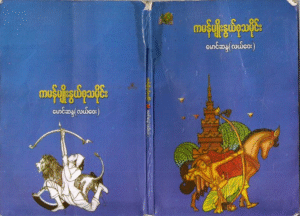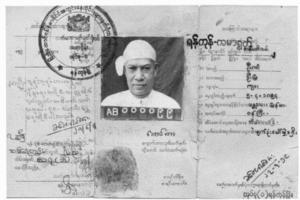By Zaw Zaw Latt
(Translated and edited for MMNN)
Instead of relying on emotion alone, let us speak with truth, evidence, and historical documentation.
Much of the Muslim population in Myanmar today—often referred to as Burmese Muslims or Pathi—are not recent arrivals but descendants of indigenous communities who have lived here for centuries. These Pathi Muslims have played vital roles in the nation’s history, governance, military, and fight for independence.
1. Pathi Presence and Contributions from Ancient Times
As early as King Anawrahta’s reign, Pathi men were contributing to national service. Historical sources record their involvement in projects such as the building of Meiktila Lake in both 393 ME and again in 784 ME. These efforts were supported by Pathi soldiers, as documented in Hanthawaddy U Ba Thin’s cultural journals and letters compiled by Kinwun Mingyi.
In the 13th century, the city of Pathein was reportedly governed by Pathi rulers, as confirmed in Myanmar Encyclopedia Vol. 6 and Pathein Yazawin by U Magha.
The Konbaung dynasty—Myanmar’s final royal era—trusted Pathi officers in key military and administrative posts. One notable example was Du Karein, a brave young officer who crushed rebellions under King Bodawpaya and was later promoted to Commander of the Royal Guard. He served as a diplomat to Yunnan and aide to the great General Maha Bandula.
King Mindon, a known reformist, acknowledged his Muslim subjects’ contributions. During royal ceremonies in 1215 ME, he made sure Muslim officers were served food prepared according to halal customs and honored Pathi cavalry troops such as Commander Wali Khan and his 700 horsemen with traditional Burmese garments.
2. Recognition and Respect Under King Mindon
Pathi Muslims were not only permitted but encouraged to build mosques and settle in designated districts within newly built Mandalay. The king allocated twelve major residential areas to the Pathi, including Sagaing Tine, Ohbo, and Wali Khan Ward, and permitted the construction of mosques within the royal compound itself. Notably, the Shwe Panneik Mosque—Golden Canopy Mosque—was built inside the palace so that Pathi guards could pray without difficulty.
King Mindon even built a rest house and donated a landmark pillar in Mecca for Burmese Muslims performing Hajj, reflecting his deep respect for their faith and dignity abroad.
3. Continued Military Service under King Thibaw
During the reign of Myanmar’s last monarch, King Thibaw, over 24,000 fully armed troops participated in a grand military parade. Among them were four full battalions of Muslim artillerymen:
- 133 Pathi soldiers under Artillery Commander Hashim (Sakra Battalion)
- 113 Pathi soldiers under Mingalar Artillery Commander U Kya
- 113 Pathi soldiers under Sule Gon Commander U Maung
- 113 Pathi soldiers under Bomb Shell Commander U Yauk
These records are preserved in the Konbaung Chronicle, pp. 516 & 524.
During the Third Anglo-Burmese War, prominent Pathi figures such as Akkabat Myinwon, the Port Commissioner, and Maha Min Htin Yaza led troops in the Southern Division. Historical records confirm that Maha Min Htin Yaza later served as mayor of Mandalay.
4. Participation in Anti-Colonial and Independence Struggles
Pathi Muslims did not disappear after the fall of the monarchy. They actively resisted colonialism, participated in the anti-fascist movement against Japanese occupation, and supported the push for independence.
In the early independence era, under the leadership of U Razat, Burmese Muslims from all ethnic backgrounds—including the Pathi—formed the Burmese Muslim Awakening Organization. As independence neared, General Aung San personally urged U Razat to organize Burmese Muslims into a unified political body. This led to the formation of the Burmese Muslim Congress (BMC).
Under General Aung San’s guidance, the BMC participated as an allied body within the Anti-Fascist People’s Freedom League (AFPFL), contributing significantly to the independence movement.
5. Recognition at the 1946 Constituent Assembly
At the historic 1946 AFPFL Constituent Assembly, a motion—Proposal No. 6—was submitted by U Ba Cho, a respected Muslim scholar. The motion declared that Muslims born in the country and descended from generations of service had loyally contributed to Myanmar’s military, anti-colonial, and anti-fascist efforts. It recommended that these Burmese-born Muslims be officially recognized as a national minority with full rights.
The assembly unanimously approved the proposal.
However, at the opening of the Burmese Muslim Congress convention, U Razat addressed the community with foresight:
“While we are grateful for the recognition granted by the AFPFL, we are in a critical transitional time. In this heated period of the independence struggle—when colonial threats still linger—if we insist too strongly on a separate ethnic identity, we risk being viewed as opponents of the national cause. This issue can be revisited once our independence is secure. For now, I suggest we stand firmly and proudly as Burmese—united as one nation.”
Though the statement initially caused some debate, U Razat’s wisdom prevailed, and the community united behind his stance.
Tragically, U Razat and many Muslim leaders were assassinated by extremist forces before independence could be fully realized.
6. From Nation Builders to Forgotten Citizens
After independence, some Burmese Muslim leaders were appointed as ministers, deputy ministers, and members of parliament. However, the broader issue of full recognition for Burmese-born Muslims—particularly the Pathi—remained unresolved.
Under military regimes, Muslims faced escalating discrimination: in religion, ethnicity, and ultimately, identity. Today, the descendants of these loyal Burmese Muslims are confronting a final, chilling chapter—their total erasure from national memory.
Closing Reflection
The stories above are just one part of a much deeper and wider historical truth: the Pathi—the largest segment among Myanmar’s Muslim citizens—have long been part of this land’s heritage.
Other Muslim communities in Myanmar, from various ethnic backgrounds, also have rich histories that deserve recognition. But this particular chapter—the legacy of the Pathi—must not be forgotten.
May we all have the strength to see the truth clearly and understand history justly.
Zaw Zaw Latt (Asteroid)
Zaw Zaw Latt
ဝေဒနာတွေမဖြစ်အောင်.. ဒေတာတွေနဲ့ ပြောကြရအောင်..![]()
![]()
![]()
![]()
![]()
လူမျိုးရောကျို ဖျောက်ဖျက်ခံလာရသော ဗမာမွတ်စလင်/မြန်မာမွတ်စလင်ခေါ် ပသီ လူမျိုးများရဲ့အကြောင်းတစေ့တစောင်း….
မြန်မာနိုင်ငံအတွင်းမှာ ဖြစ်တည်ရှိနေတဲ့ အစ္စလာမ်ဘာသာ၀င် အများစုဟာ အတိတ်ခေတ်အဆက်ဆက် ဆင်းသက်လာကြတဲ့ ဗမာမွတ်စလင်ခေါ် ပသီ လူမျိုးများပင်ဖြစ်ကြပါတယ်။ လွန်ခဲ့သောနှစ်ပေါင်းများစွာက အနော်ရထာခေတ်မှာပင် ပသီအမျိုးသားများ နိုင်ငံတာ၀န်ထမ်းဆောင်ခဲ့ကြကြောင်းကိုလည်း သမိုင်းမှာအထင်အရှားတွေ့မြင်နိုင်ပါတယ်။ မြန်မာသက္ကရာဇ် ၃၉၃ ခုနှစ်၊ အနော်ရထာမင်းလက်ထက်တွင် မိတ္ထီလာကန်ကြီးဆည်ဖို့ရာတွင် ပသီလက်ကိုင်တပ်များ ပါ၀င်ခဲ့ကြောင်းကို (ဟံသာ၀တီဦးဘရင်ရေးသားခဲ့သော မြန်မာ့ယဉ်ကျေးမှုနှင့် လယ်သမားရေးရာစာစောင် စာမျက်နှာ ၂၅)မှာ ဖော်ပြထားတာကိုတွေ့ရပါတယ်။ ထို့နောက် မင်းခေါင်းအနော်ရထားခေတ် သက္ကရာဇ် ၇၈၄ ခုနှစ်မှာလည်း မိတ္ထီလာကန်ကို ဒုတိယအကြိမ်ဆည်ဖို့ရာတွင်လည်း ပသီလက်နက်ကိုင် တပ်သားတစ်ထောင်ကျော် လိုက်ပါဆည်ဖို့ခဲ့ရသည်ဟူ၍လည်း (ကင်း၀န်မင်းကြီး စာပေါင်းစုစာမျက်နှာ ၈၆)တွင် ဖော်ပြထားပါတယ်။ ထို့အပြင် ပုသိမ်မြို့ဟာဆိုရင် ၁၃ ရာစုနှစ်အတွင်းပသီများ အုပ်ချုပ်ခဲ့တဲ့မြို့ ဖြစ်ခဲ့ဖူးကြောင်းကို (စွယ်စုံကျမ်းအတွဲ ၆၊ စာမျက်နှာ ၃၅၀)တွင် ဖော်ပြထားသလို (ဦးမာဃ ရေးသားသော ပုသိမ်ရာဇ၀င်)တွင်လည်း တွေ့ရှိရပါတယ်။ သစ္စာရှိမှု ယုံကြည်စိတ်ချရမှုများကြောင့် ကုန်းဘောင်မင်းဆက် ၁၁ ဆက်လုံးမှာ ပသီလူမျိုးများကို တာ၀န်များခန့်အပ်ပေးခဲ့တာတွေကိုလည်း သမိုင်းစာမျက်နှာအမြောက်အများမှာ တွေ့မြင်နိုင်ပါတယ်။ မြန်မာသက္ကရာဇ် ၁၁၈၂ ခုနှစ် ဘကြီးတော်စစ်ကိုင်းမင်းလက်ထက်မှာ ကသည်းပြည်ပုန်ကန်မှုတွင် ရွပ်ရွပ်ချွံချွံကွပ်ကဲတိုက်ခိုက်ခဲ့သော စစ်ဗိုလ်ကလေးပသီလူမျိုး ဒူကရင် ကို ဘုရင်မှ ဂုဏ်ပြုသောအားဖြင့် ခံတပ်ဗိုလ်ကြီးအဖြစ် ခန့်အပ်တာ၀န်တိုးပေးခဲ့တာတွေကိုလည်း (ကုန်းဘောင်မင်းဆက်မဟာရာဇ၀င်တော်ကြီး ဒုတိယတွဲ၊ စာမျက်နှာ ၂၆၈,၂၆၉)တို့မှာ ဖော်ပြထားပါတယ်။ ထို့အပြင် ခံတပ်ဗိုလ် ဒူကရင်ဟာဆိုရင် နေမျိုးဂုဏ္ဏဘွဲ့ကိုပါထပ်မံချီးမြှင့်ခြင်းခံခဲ့ရကာ စစ်သူကြီးမဟာဗန္ဓုလရဲ့ လက်စွဲတော်ဖြစ်ခဲ့ကြောင်း၊ ယွန်းပြည်ကြီးသို့ သံတမန်အဖြစ် စေလွှတ်ခြင်းခံခဲ့ရကြောင်းများကို (ကုန်းဘောင်မင်းဆက် မဟာရာဇ၀င်တော်ကြီး၊ ဒုတိယတွဲ၊ စာမျက်နှာ ၃၉၂)တွင် တွေ့ရပါတယ်။
မြန်မာသက္ကရာဇ် ၁၂၁၅ ခုနှစ်မှာ ဘ၀ရှင်မင်းတရားကြီးဟာ သံဃာတော်ရှစ်ပါးအား ဆွမ်းဖိတ်ကျွေးဥပုသ်ယူခဲ့ရာတွင် ထိုအခမ်းအနားမှာ မင်းမှုထမ်းတွေကိုလည်း ကျွေးမွေးပြုစုခဲ့ရာမှာ ဘာသာခြားပသီမင်းမှုထမ်းများလည်း စားလို့ရရန် ပသီဓလေ့ထုံးစံအတိုင်း ချက်ပြုတ်ကျွေးမွေးတော်မူပြီး ပသီမြင်းတပ်ဗိုလ် ၀လီခန် နှင့် ပသီမြင်းတပ်သား ၇၀၀ ကျော်ကို ပုဆိုးခေါင်းပေါင်းများ ပေးလှူစေခဲ့ကြောင်းကို (ကုန်းဘောင်ခေတ် မဟာရာဇ၀င်တော်ကြီး တတိယတွဲ စာမျက်နှာ ၁၇၀)တွင် ဖော်ပြထားပါတယ်။ နိုင်ငံတော်ကာကွယ်ဖို့အတွက် ရန်ဖြိုခွင်းအမြောက်တပ်၊ ရန်ပုံခွင်းအမြောက်တပ်၊ ရန်ကင်းအမြောက်တပ်၊ ရန်လင်း အမြောက်တပ်၊ လက်မနိတ်အမြောက်တပ်ဆိုတဲ့ တပ်ကြီးတွေမှာ တပ်မှူးတပ်သားများအပါအ၀င် မြေဒူးပသီများ ပါ၀င်ခဲ့ကြောင်းကို (မြန်မာမင်းလက်ထက်တော်စာတမ်းများ စာမျက်နှာ ၆၆,၁၇,၇၂)တို့မှာ တွေ့ရပါတယ်။ မြန်မာသက္ကရာဇ် ၁၂၈၉ ခုနှစ်၊ ဝါခေါင်လဆန်း ၃ ရက်နေ့မှာ ရတနာပုံမြို့သစ်တည်ရေးအတက် ချုံခုတ်ထွင်ရှင်းလင်းရာတွင်လည်း ဗိုလ်မင်းထင်ရာဇာဦးစီးတဲ့ ပသီတပ်သားလေးရာကျော် ပါ၀င်ခဲ့ကြောင်းကို သမိုင်းတွေမှာ ဖော်ပြထားကြပါတယ်။ ရတနာပုံမန္တလေးမြို့တည်ဆောက်ပြီးစီး တဲ့အခါမှာလည်း လူမျိုးစုအလိုက်သူ့အစုအဝေးနှင့်သူ မင်းတုန်းမင်းတရားကြီးက နေရာချပေးခဲ့ရာမှာ ပသီလူမျိုးတို့အား စစ်ကိုင်းတန်း၊ ကုန်းရိုးတန်း၊ တောင်ဘလူ၊ အိုးဘို၊ စကြာနွယ်စဉ်အမြောက်တန်း၊ ဂျွန်းတန်း၊ ၀လီခန်ရပ်၊ တိုက်တန်း၊ ကိုယ်ရံတော်ရပ်၊ တောင်အပ်ချုပ်၊ မြောက်အပ်ချုပ်၊ ကုလားပျိုရပ် စသည့် ရပ်ကွက်ကြီး ၁၂ ကွက်ကို နေရာချပေးပြီး ဗလီ၀တ်ကျောင်းတော်များကိုလည်း ၀တ်ပြုဖို့ သတ်မှတ်ပေးခဲ့တယ်ဆိုတာကို (ဦးမောင်မောင်တင်၊ မဟာဝိဇ္ဇရေးသော မြန်မာမင်းလက်ထက်တော်စာတမ်း၊ စာမျက်နှာ ၇၂)တွင် ဖော်ပြထားပါတယ်။ ထို့အပြင် မင်းတုန်းမင်းတရားကြီးဟာ ၄င်းရဲ့လက်ျာဘက်မှာ ခံစားရတဲ့ ရွေးလက်ျာပသီတပ်သားများ ရွေးနန်းတော်တွင်းမှ အပြင်ထွက်ပြီး တစ်နေ့ငါးကြိမ်၀တ်ပြုရတဲ့ အခက်အခဲကိုသိပြီး ရွှေနန်းတော်ထဲ၌ပင် မင်းတုန်းမင်းကြီးကိုယ်တိုင် ရွှေပန္နက်ချပေးပြီး ဗလီတစ်လုံးကို ဆောက်လုပ်ပေးခဲ့ပါတယ်။ ထို့ကြောင့်ထိုဗလီ၀တ်ကျောင်းတော်ကို ရွှေပန္နက်ဗလီဟူ၍ ခေါ်ဝေါ်ခဲ့ကြပါတယ်။ ထို့အပြင် မင်းတုန်းမင်းတရားကြီးဟာ သူ၏တိုင်းနိုင်ငံသား အစ္စလာမ်ဘာသာ၀င်များ ဆော်ဒီအာရေးဗျနိုင်ငံ မက္ကာမြို့သို့ ဟဂ်ျဘုရားဖူးသွားရာတွင် မျက်နှာမငယ်ရစေရန် မက္ကာမြို့တော်၌ ဒေါင်းတံဆိပ်ကြီးနှင့် တည်းခိုဆောင်တစ်ခုကို ဆောက်လုပ်လှူဒါန်းပေးခဲ့ပါတယ်။
သီပေါမင်းလက်ထက်တွင် စစ်သည်ရဲမက်အမှုထမ်း အမြဲတမ်းရဲမက်တော် နှစ်သောင်းလေးထောင်ကျော်တို့ ချပ်၀တ်တန်ဆာအပြည့်အစုံနှင့် ရှေ့တော်မှောက်သို့တပ်အစဉ်အတိုင်း ခင်းကျင်းပြသစေဟူသော အမိန့်ဖြင့် စစ်အင်္ဂါခင်းပြီး ပြသကြရာထို့အထဲတွင် စကြာအမြောက်တပ် တပ်မင်းဗိုလ်မှူးဟာရှင် ကွပ်ကဲသော အမြောက်အမှုထမ်းပသီတပ်သား ၁၃၃ ယောက်ပါ တပ်တစ်တပ်၊ မင်္ဂလာအမြောက်ဗိုလ်ဦးကြယ်နှင့် ပသီတပ်သား ၁၁၃ ယောက်ပါ တပ်တစ်တပ်၊ မင်္ဂလာအမြောက် ဆူးလေကုန်းဗိုလ်ဦးမောင်နှင့် ပသီတပ်သား ၁၁၃ ယောက်ပါ တပ်တစ်တပ်၊ မင်္ဂလာအမြောက်ဗုံးအိုးဗိုလ်ဦးယောက် နှင့် ပသီတပ်သား ၁၁၃ ယောက်ပါ တပ်တစ်တပ် စသည့် ပသီအမြောက်တပ်များ ပါ၀င်ခဲ့ကြောင်းကို (ကုန်းဘောင်ဆက် မဟာရာဇ၀င်တော်ကြီး စာမျက်နှာ ၅၁၆,၅၂၄)တို့မှာ ဖော်ပြထားပါတယ်။ ထို့နောက် အင်္ဂလိပ်-မြန်မာ တတိယစစ်ပွဲမှာ တောင်တွင်းကြီးစစ်ကြောင်းတွင် တပ်မမှူးအဖြစ် ပသီလူမျိုး အက္ကဘတ်မြင်း၀န်၊ ပင်လယ်မြို့စားကြီး၊ မင်းကြီးမဟာမင်းထင်ရာဇာ ပါ၀င်ခဲ့တယ်ဆိုတာ (ကုန်းဘောင်မင်းဆက် မဟာရာဇ၀င်တော်ကြီး၊ တတိယတွဲ၊ စာမျက်နှာ ၇၁၂)တွင် ဖော်ပြထားပါတယ်။ ထို့အပြင် သူဟာဆိုရင် မန္တလေးမြို့တော်၀န် တာ၀န်ယူခဲ့သူလည်းဖြစ်ကြောင်း တွေ့ရပါတယ်။
ထို့နောက် ဖက်ဆစ်ဂျပန်တော်လှန်ရေးတွင်းလည်းကောင်း၊ လွတ်လပ်ရေးကြိုးပမ်းမှုများတွင် လည်းကောင်း၊ ဒီကနေ့ ဗမာမွတ်စလင်လို့ခေါ်နေကြတဲ့ ပသီများဟာ အသက်သွေးချွေးပဓာနမထားဘဲ ပါ၀င်ခဲ့ကြတာကိုလည်း ခေတ်အဆက်ဆက်သမိုင်းမှာ အထင်အရှားတွေ့နိုင်ပါတယ်။ ဗမာ့လွတ်လပ်ရေးကြိုးပမ်းမှုအစောပိုင်းကာလမှာ ဆရာကြီးဦးရာဇတ်ခေါင်းဆောင်ပြီး လွတ်လပ်ရေးကြိုးပမ်းဖို့အတွက် မြန်မာနိုင်ငံသား လူမျိုးပေါင်းစုံ မွတ်စလင်များဖြင့် ဗမာမွတ်စလင်နိုးကြားရေးအဖွဲ့ ဆိုတာပေါ်ပေါက်ခဲ့ပါတယ်။ လွတ်လပ်ရေး တောင်းဆိုရမည့်အချိန် နီးကပ်လာတဲ့ကာလတွေမှာတော့ ဗိုလ်ချုပ်အောင်ဆန်းကိုယ်တိုင် ဆရာကြီးဦးရာဇတ်အား ဗမာပြည်ရှိ မွတ်စလင်များစည်းရုံးပြီး လွတ်လပ်ရေးကြိုးပမ်းရာမှာ ဗမာမွတ်စလင်များ အင်အားစုတစ်ခုအနေနှင့် အဖွဲ့အစည်းတစ်ရပ် ဖွဲ့စည်းဖို့တိုက်တွန်းခဲ့ပါတယ်။ ထို့ကြောင့် ယခင်ဗမာမွတ်စလင်နိုးကြားရေး အင်အားစုများနှင့် နောက်ထပ်လိုလားသူများပေါင်းပြီး ဗမာမွတ်စလင် ကွန်ဂရက်(ဗမက)အဖွဲ့ကြီး ပေါ်ပေါက်လာခဲ့ပါတယ်။ အဆိုပါ ဗမာမွတ်စလင်ကွန်ဂရက်အဖွဲ့ကို ဗိုလ်ချုပ်အောင်ဆန်းရဲ့ လမ်းညွှန်မှုနှင့်အညီ ဖဆပလအဖွဲ့ကြီးနှင့် တပ်ပေါင်းစုအဖွဲ့အဖြစ် ပါ၀င်ဆောင်ရွက်ကြိုးပမ်း ခဲ့ကြတာကိုလည်း သမိုင်းမှတ်တမ်းများမှာ အထင်အရှားတွေ့နိုင်ပါတယ်။
ဒါကြောင့်လည်း ၁၉၄၆ ခုနှစ် ဖဆပလ ဥပဒေပြုညီလာခံကြီးမှာ ဗိုလ်ချုပ်အောင်ဆန်းလမ်းညွှန်မှုအရ ဆရာကြီးဒီဒုတ်ဦးဘချိုက ပြည်ထောင်စုဇာတိဖွား မွတ်စလင်များသည် အတ်ိတ်ခေတ်အဆက်ဆက် တိုင်းပြည်တာ၀န်ကျေးပွန်ခဲ့ကြသလို လွတ်လပ်ရေးကြိုးပမ်းရာမှာ ပါ၀င်ခဲ့ကြကာ၊ နယ်ချဲ့ကို တော်လှန်ရာမှာသော်လည်းကောင်း၊ ဖက်ဆစ်တော်လှန်ရာမှာသော်လည်းကောင်း သက်စွန့်ကြိုးပမ်းတာ၀န်ကျေပွန်ခဲ့တာကြောင့် ဤဥပဒေပြုညီလာခံကြီးမှ ပြည်ထောင်စုဇာတိဖွားမွတ်စလင်တို့အား ဇာတိဆိုင်ရာလူမျိုးရေးလူနည်းစု အခွင့်အလမ်းများ ပေးအပ်ရန်ကို အဆိုအမှတ်(၆)အဖြစ် တင်သွင်းခဲ့ရာ ညီလာခံကြီးက တစ်ခဲနက်အတည်ပြု ထောက်ခံပေးခဲ့ကြပါတယ်။
ထို့သို့ ဖဆပလညီလာခံကြီးက ထောက်ခံအတည်းပြုပေးခဲ့သော်လည်း ဗမာမွတ်စလင်ကွန်ဂရက်(ဗမက)ဦးစီးညီလာခံကြီး ကျင်းပတဲ့အခါမှာတော့ သဘာပတိ ဆရာကြီးဦးရာဇတ်မှ အဖွင့်မိန့်ခွန်းပြောကြားခဲ့ရာမှာ “ဖဆပလ ညီလာခံကြီးကတော့ ကျွန်တော်တို့ တစ်မျိုးသားလုံးအပေါ် ထိုက်တန်တဲ့ ဇာတိဆိုင်ရာလူမျိုးရေး၊ လူနည်းစုအခွင့်အလမ်းပေးတာကို ၀မ်းသာအားရ ကျေးဇူးတင်ပါသော်လည်း လွတ်လပ်ရေးယူရတော့မယ့် ဒီလိုပူပူနွေးနွေးကာလမှာ နယ်ချဲ့ကလည်း အနီးကပ်ရှိနေတဲ့ ဒီလိုအချိန် ဗမာလူမျိုးတွေနှင့် သွေးထိုးလှုံ့ဆော်ဖန်တီးလာရင် တိုင်းရင်းသားဇာတိဖွား မွတ်စလင်တွေ လွတ်လပ်ရေးရဲ့ တရားခံဖြစ်သွားနိုင်တယ်။ ဒီကိစ္စကို လွတ်လပ်ရေးခိုင်မာတဲ့ကာလမှ ပြန်လည်ဖြေရှင်းလို့ရတဲ့ကိစ္စပဲ။ ဒီတော့ ကျွန်တော့်အနေနှင့် အကြံပြုချင်တာကတော့ ကျွန်တော်တို့ တစ်မျိုးသားလုံး လူများစု၊ ဗမာများအဖြစ်ရပ်တည်ထားရင်ကောင်းမယ် ထင်ပါတယ်”လို့ ပြောကြားခဲ့ပါတယ်။ ထို့အချိန်မှာတော့ ညီလာခံဦးစီးများ လှုပ်လှုပ်ရှားရှား အငြင်းပွားကြတာရှိခဲ့သော်လည်း ညီညီညွတ်ညွတ်နဲ့ပဲ ဆရာကြီးဦးရာဇတ်ရဲ့ မူကို နှလုံးသွင်းလက်ခံသဘောတူခဲ့ကြပါတယ်။ ထို့နောက်များမှာ နယ်ချဲ့လက်ပါးစေများရဲ့ လုပ်ကြံမှုကြောင့် ဆရာကြီးဦးရာဇတ်အပါအ၀င် အာဇာနည်ကြီးများ ကျဆုံးပြီး လွတ်လပ်ရေးရပြီး နောက်မှာတော့ ကျန်ရှိနေတဲ့ ကျွန်တော်တို့ ဗမာမွတ်စလင်ခေါင်းဆောင်များဟာ ၀န်ကြီး၊ ၀န်လေး၊ အမတ်မင်းရာထူးများရရှိခဲ့ကြပေမယ့် မပြီးဆုံးသေးတဲ့ ပြည်ထောင်စုဇာတိဖွား ဗမာမွတ်စလင်/ပသီများရဲ့အရေးဟာတော့ မေးမိန်သွားခဲ့ရပါတယ်။ စစ်အုပ်ချုပ်မှုကာလ ဘာသာရေးလူမျိုးရေး ခွဲခြားဆက်ဆံမှု၊ ဖိနှိပ်မှုတွေနှင့်အတူ လူမျိုးရောကျိတ်ခံထားခဲ့ရပြီး ယခုကျွန်တော်တို့ခေတ် အချိန်အခါမှာတော့ လူမျိုးလုံးဝဖျောက်ဖျတ်နေတာကိုပါ ခံရပါတော့တယ်။
ဒီအကြောင်းအရာများဟာ မြန်မာနိုင်ငံရှိ အစ္စလာမ်ဘာသာကိုးကွယ်သည့် မွတ်စလင်များအတွင် အများဆုံးဖြစ်သည့် သမိုင်းကြောင်းကြီးမားလှတဲ့ ပြည်ထောင်စုဇာတိဖွား ကျွန်တော်တို့ ဗမာမွတ်စလင်ခေါ် ပသီများရဲ့ အကြောင်းဖြစ်ပြီး တခြားလူမျိုးမတူပဲ မွတ်စလင်ဖြစ်ခြင်းတူတဲ့ နိုင်ငံသားမွတ်စလင်လူမျိုးတွေရဲ့ သမိုင်းကြောင်းတွေလည်း များစွာရှိပါသေးတယ် ဆိုတာကိုပြောကြားရင်း ကျွန်တော်ရဲ့စာကို အဆုံးသတ်လိုက်ပါတယ်…..။
![]() အမှန်ကိုမြင်နိုင်းစွမ်းရပြီး အမြင်မှန်နိုင်ကြပါစေ
အမှန်ကိုမြင်နိုင်းစွမ်းရပြီး အမြင်မှန်နိုင်ကြပါစေ ![]()
ဇော်ဇော်လတ်✰အဲ့စ်တာရွိက်ဒ်✰





